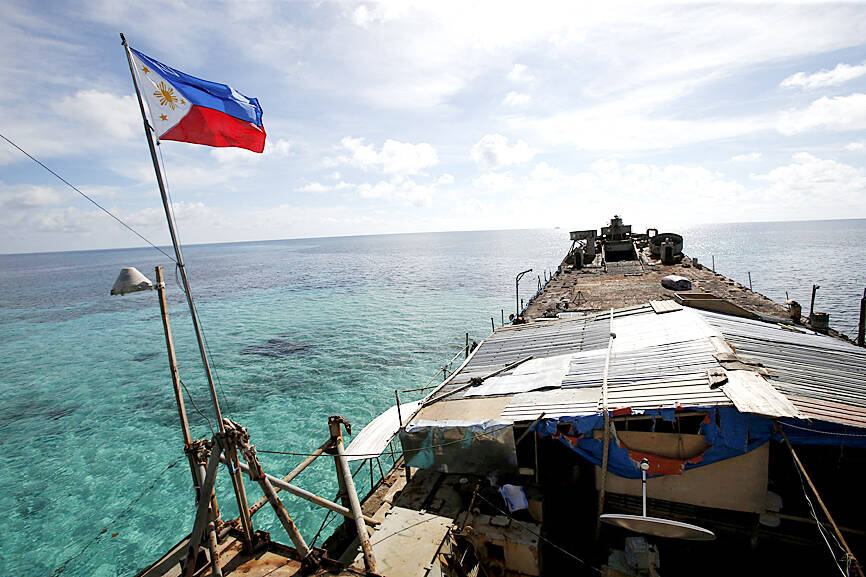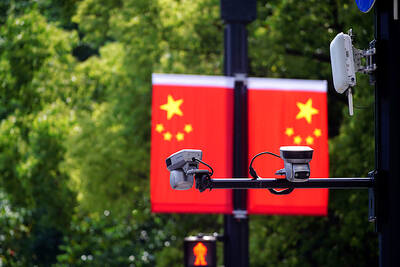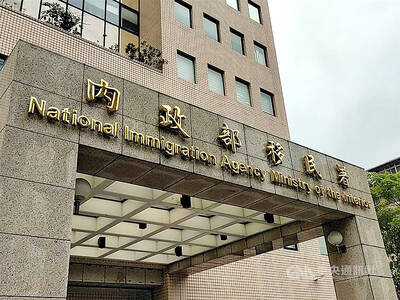A US-funded project to expand a Philippine civilian port facing a strategically crucial channel could assist US allies in the Pacific, including Taiwan, in the event of a conflict with China, military experts said.
Kyodo News on Saturday last week reported that work to expand the port facing the Bashi Channel — a project first announced last year — was under way.
The report cited Batanes Governor Marilou Cayco at a Philippine Navy event saying that the plan, developed in coordination with the Philippine military, aimed to help its citizens leave Taiwan in the event of a cross-strait crisis.

Photo: Reuters
The US Army is to arrive late next month to further discuss the new facility, the report quoted Cayco as saying.
Batanes is the northernmost province of the Philippines. One of its islands, Mavudis, is closest to Taiwan, just 99km from Orchid Island (Lanyu, 蘭嶼) and about 142km from Oluanpi (鵝鑾鼻), Taiwan proper’s southernmost tip.
Institute for National Defense and Security Research research fellow Su Tzu-yun (蘇紫雲) on Tuesday told reporters that despite the port’s stated function, it is really a preventative move by the US to bolster its crisis management ability.
The planned port does not signal an increased risk of war between Taiwan and China, but is rather part of the US deterrence strategy targeting China.
Guermantes Lailari, a visiting researcher at the institute, agreed that the expansion of the port was a “defensive act” by Washington and Manila, and did not necessarily signal a rising risk of a cross-strait conflict.
The port could function as a commercial facility, but it could also be used for military purposes if needed, said Lailari, a retired US Air Force lieutenant colonel.
The Philippines wanted to expand the port, which is “very small,” so that it can handle larger ships, he said.
On the strategic significance of the port’s expansion, Su said it would enable the US to blockade Chinese People’s Liberation Army (PLA) forces from reaching waters east of Taiwan through the Bashi Channel.
The port also relates to Taiwan and Japan’s strategy of blocking China from crossing the first island chain, a string of islands that run from the Japanese archipelago, through Taiwan, the Philippines and on to Borneo, he said.
The Philippines has also deployed BrahMos anti-ship missiles in Basco on the Batan Islands, he said.
The move, along with Japan deploying anti-ship missile systems in the Miyako Strait on its Yonaguni and Miyako islands, and Taiwan’s Hsiung Feng anti-ship missiles, forms a north-south blockade against China, Su added.
The port was part of a strategy covering the northern and southern parts of Taiwan, referencing the deployments of Japan Self Defense Forces and their anti-ship capabilities near the Senkaku Islands, Lailari said.
Taiwan claims the Senkakus, calling them the Diaoyutai Islands (釣魚台).
The Batanes port is strategic given its proximity to Taiwan and that US forces can operate from it.
In addition, under the Enhanced Defense Cooperation Agreement between the US and the Philippines, which was signed in 2014, the US can also access nine other sites.
If China were to invade Taiwan, the PLA would need to send forces through the Bashi Strait to the east of the country to stop incoming support from the US and Taiwan’s other allies, Lailari said.
The port’s location could be great for intelligence collection and monitoring PLA ship and aircraft movements, he said.
Should there be a need for power projection from the Philippines in support of Taiwan, Batanes would also be an ideal location from which forces, equipment or weapons could be sent, he said.
The port expansion shows that the US is helping Taiwan’s neighbors prepare for conflict, Lailari said.
“By increasing defense, you’re also increasing deterrence,” he said. “This sends a message to communist China that the US is serious. And hopefully, [Chinese President] Xi Jinping [習近平] will decide not to do anything.”

CAUTION: Based on intelligence from the nation’s security agencies, MOFA has cautioned Taiwanese travelers about heightened safety risks in China-friendly countries The Ministry of Foreign Affairs (MOFA) yesterday urged Taiwanese to be aware of their safety when traveling abroad, especially in countries that are friendly to China. China in June last year issued 22 guidelines that allow its courts to try in absentia and sentence to death so-called “diehard” Taiwanese independence activists, even though Chinese courts have no jurisdiction in Taiwan. Late last month, a senior Chinese official gave closed-door instructions to state security units to implement the guidelines in countries friendly to China, a government memo and a senior Taiwan security official said, based on information gathered by Taiwan’s intelligence agency. The

The National Immigration Agency (NIA) said yesterday that it will revoke the dependent-based residence permit of a Chinese social media influencer who reportedly “openly advocated for [China’s] unification through military force” with Taiwan. The Chinese national, identified by her surname Liu (劉), will have her residence permit revoked in accordance with Article 14 of the “Measures for the permission of family- based residence, long-term residence and settlement of people from the Mainland Area in the Taiwan Area,” the NIA said in a news release. The agency explained it received reports that Liu made “unifying Taiwan through military force” statements on her online

Taiwan Semiconductor Manufacturing Co (TSMC), the world’s largest contract chipmaker, said yesterday that it is looking to hire 8,000 people this year, at a time when the tech giant is expanding production capacity to maintain its lead over competitors. To attract talent, TSMC would launch a large-scale recruitment campaign on campuses across Taiwan, where a newly recruited engineer with a master’s degree could expect to receive an average salary of NT$2.2 million (US$60,912), which is much higher than the 2023 national average of NT$709,000 for those in the same category, according to government statistics. TSMC, which accounted for more than 60 percent

Tung Tzu-hsien (童子賢), a Taiwanese businessman and deputy convener of the nation’s National Climate Change Committee, said yesterday that “electrical power is national power” and nuclear energy is “very important to Taiwan.” Tung made the remarks, suggesting that his views do not align with the country’s current official policy of phasing out nuclear energy, at a forum organized by the Taiwan People’s Party titled “Challenges and Prospects of Taiwan’s AI Industry and Energy Policy.” “Taiwan is currently pursuing industries with high added- value and is developing vigorously, and this all requires electricity,” said the chairman